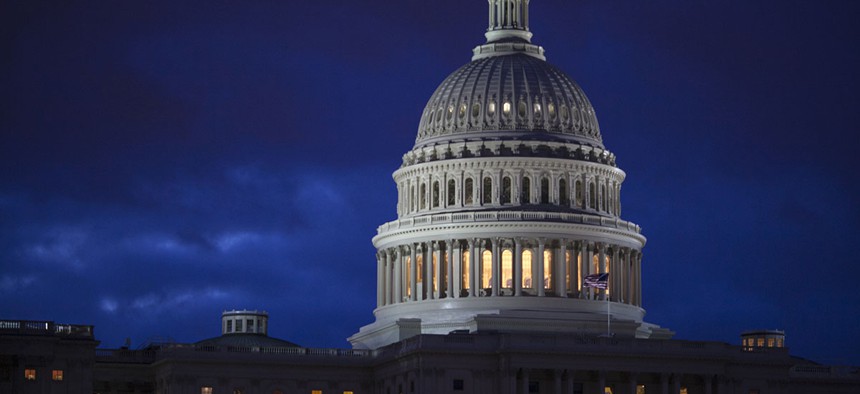If the Government Shuts Down, Some of Its Websites, Databases and IT Do Too

J. Scott Applewhite/AP File Photo
OMB’s 2013 guidance requires IT systems related to excepted activity, including national security, stay functional.
If Congress and the White House’s negotiations fail to avoid a government shutdown, it’s not just federal employees who don’t show up for work. Contingency plans dictate which technology remains on, gets updates or goes dark.
Agencies have been prepping for a shutdown, although as of Tuesday, it seemed less likely when the White House eased demands that funding should support a border wall with Mexico. But if Congress and the White House can’t agree on a spending measure by midnight on April 28, the federal government will technically be unfunded. The last shutdown was in 2013 after battles over the Affordable Care Act.
Press Secretary Sean Spicer told reporters this week that Office of Management and Budget Director Mick Mulvaney has done “very positive” work in the negotiations, and White House decision-makers are “very confident” that a shutdown won’t happen.
» Get the best federal technology news and ideas delivered right to your inbox. Sign up here.
If it does, federal IT systems may be affected. Federal websites, including the petition platform We The People and the Agricultural Department’s entire site, went down in 2013; others simply weren’t updated during the 16-day halt.
A 2013 OMB memo said IT systems and websites that “must operate to avoid significant damage to the execution of authorized or excepted activities” can stay functional. This might include national security, and even then just enough to “maintain functionality and ensure the security and integrity of the system during the period of the lapse.”
It's not always clear what will still be available. Earlier this week, the Environmental Protection Agency's open data site displayed a message notifying visitors that the site would be shut down Friday. EPA subsequently tweeted that rumors of the site's discontinuation were wrong, and that "[i]t's open, working & not going anywhere. This website & the EPA belong to you."
It seems a contractor supporting the database had also received mixed messages. The EPA had notified at least one company that it should "enact a shut down of our Linked Data Service in a manner that allows for it to be reconstituted at a later time," Bernadette Hyland, an open data scientist and co-founder of 3 Round Stones, a tech company selling data platforms, wrote in a blog post. Now, the site displays a notification that "The data on this Web site will continue to be available past April 28."
Here’s a look at what could happen elsewhere, based on agencies’ contingency plans posted on OMB’s site:
- The Department of Homeland Security's public website would remain accessible to the public but won't be updated or maintained, according to DHS. DHS networks supporting exempt functions would remain functional; employees working on those functions can use their DHS-issued devices or software during a shutdown. Non-exempt employees can still use their devices, but only to check for "status updates and emergency notifications from their supervisors or other management officials."
- At the Veterans Affairs Department, functions related to the VA's "need to protect life and property" would be excepted, including the Office of Information Technology's information systems, which support facilities at the Veterans Health Administration.
- The Commerce Department would continue "certain research property and critical data records," and all functions of the National Technical Information Service, but all research activities under the National Institute of Standards and Technology would be suspended.
- The Health and Human Services Department would maintain access to databases so that staff could identify problems but would halt "routine updating of databases that is normally a major part of these database operations," the plan said. IT infrastructure services would continue only to keep the National Library of Medicine data center open, which funnels information into external databases that non-federal health care providers access.
- At the Transportation Department, air traffic control systems of the Federal Aviation Administration would continue but the Office of the Inspector General would suspend “administrative functions" involving human resources, budget and financial management and IT.





